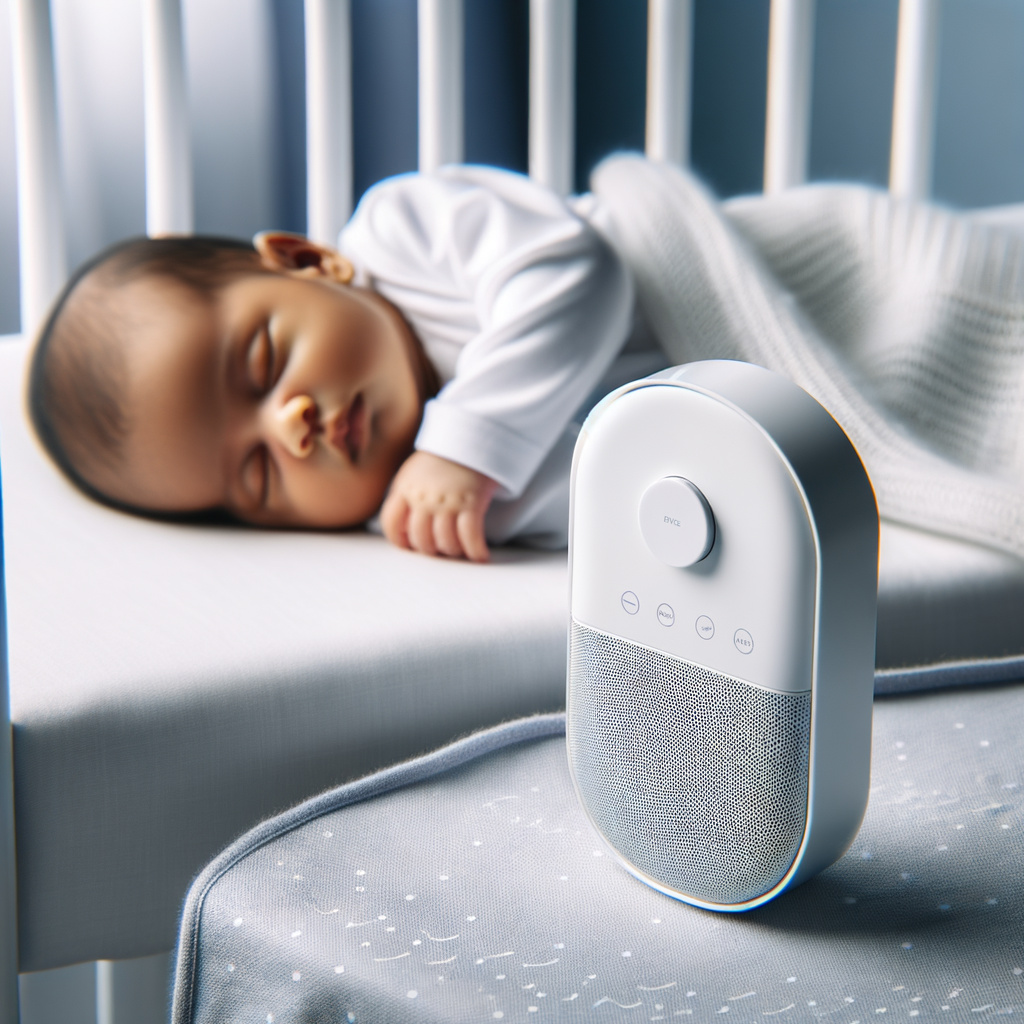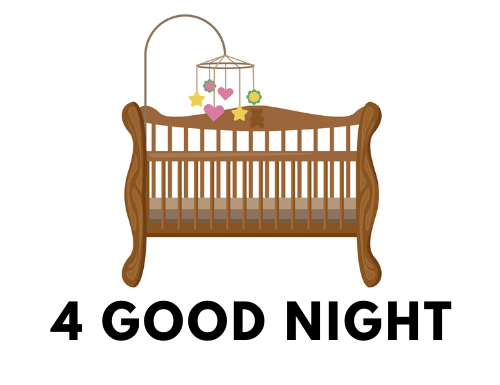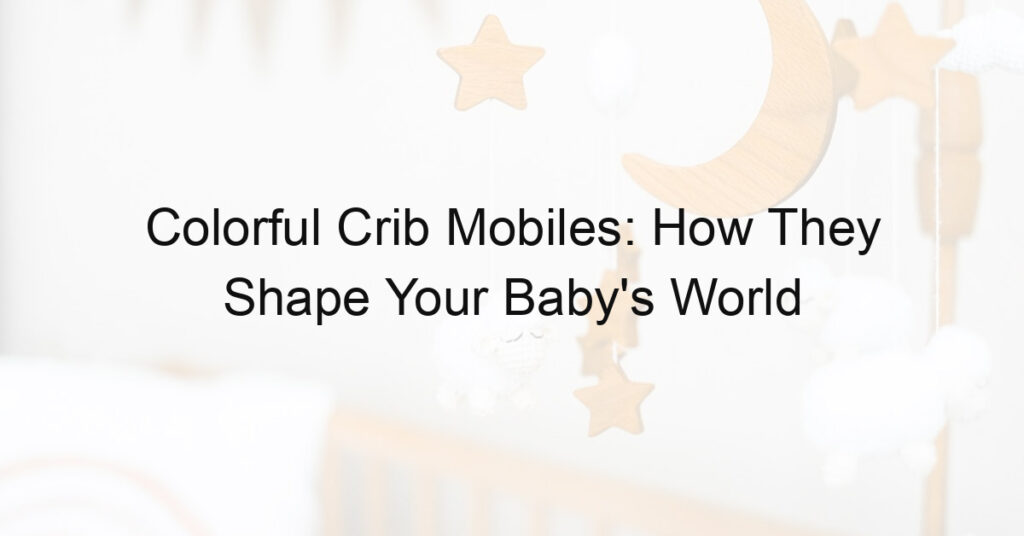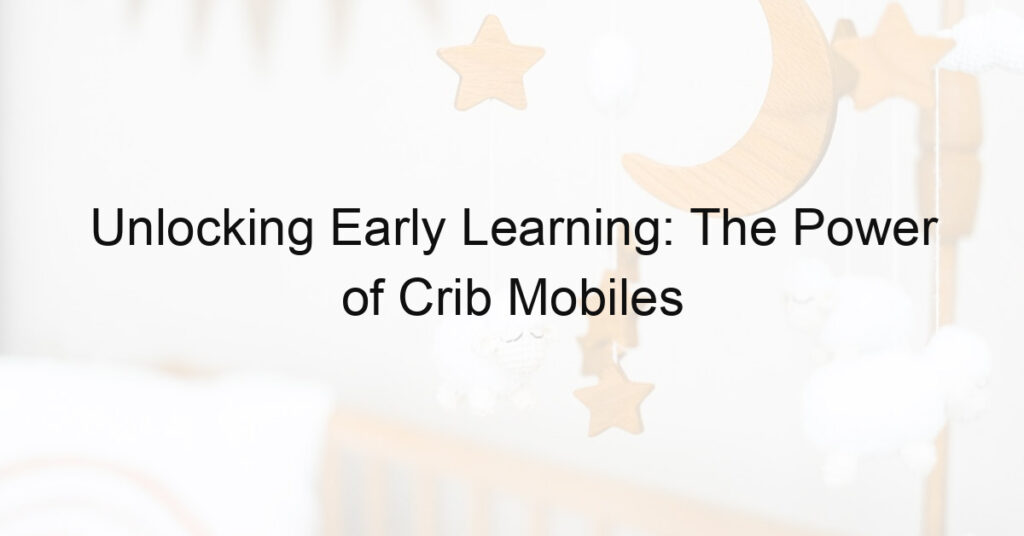
Introduction: The Magic of White Noise for Babies
Have you ever wondered why the sound of a vacuum cleaner or a running fan can soothe a fussy baby? The answer lies in the magic of white noise. This blog post will explore the concept of white noise and why it works wonders for babies.
- Understanding the concept of white noise
White noise is a special type of sound that is used to mask other sounds. Imagine you’re in a busy café, and all the chatter, clinking dishes, and background music blend into a consistent hum. That’s similar to how white noise works. It’s a steady, unchanging sound that can help mask other, more disturbing noises that might distract or disturb a baby’s sleep.
White noise contains all frequencies that are audible to the human ear, which is why it’s so effective at masking other sounds. It’s like a rainbow of sounds, all mixed together. Just as white light is a combination of all the colors of the rainbow, white noise is a combination of all different pitches of sound.
- Why white noise works for babies
Now that we understand what white noise is, let’s explore why it’s so effective for babies. The womb is a surprisingly noisy place, and babies are used to the whooshing, thumping, and gurgling sounds that are present in that environment. White noise mimics these familiar sounds, providing comfort and promoting sleep.
Furthermore, white noise helps to block out sudden, jarring noises that can startle a baby awake. It creates a safe, consistent environment that is conducive to sleep. Studies have shown that babies who listen to white noise fall asleep more quickly and sleep longer than those who don’t.
In conclusion, white noise is a simple and effective tool that can help soothe your baby and promote better sleep. As we delve deeper into this topic, we will explore how to incorporate white noise into your baby’s sleep routine, the best sound machines for babies, and other soothing sounds that can help your baby sleep.
White Noise and Newborns: A Perfect Match
White noise has been found to be a highly effective tool in helping newborns sleep. But why is this the case? Let’s delve into the science behind white noise and infant sleep.
The Science Behind White Noise and Infant Sleep
There are two main reasons why white noise is so effective in promoting sleep in infants. These are:
- How white noise mimics the womb environment
- White noise and the calming reflex
How White Noise Mimics the Womb Environment
Inside the womb, babies are surrounded by a constant noise that is similar to white noise. This noise is a combination of the mother’s heartbeat, the sound of blood flowing through the arteries, and the muffled sounds from the outside world. This constant noise is comforting to the baby and helps them feel secure.
When a baby is born, the sudden silence can be quite unsettling. White noise helps recreate the familiar sounds of the womb, providing comfort and promoting sleep.
White Noise and the Calming Reflex
The calming reflex is a natural response in babies that helps them relax and fall asleep. This reflex is triggered by certain sounds and sensations that remind the baby of being in the womb. White noise is one of these triggers.
When a baby hears white noise, it activates their calming reflex. This helps them relax, reduces their stress, and makes it easier for them to fall asleep. In fact, studies have shown that babies who listen to white noise fall asleep up to 38% faster than those who don’t.
In conclusion, white noise is a powerful tool that can help promote sleep in newborns. By mimicking the sounds of the womb and triggering the calming reflex, white noise can help your baby feel more secure and fall asleep faster.
Benefits of White Noise for Newborns
White noise has been found to offer several benefits for newborns. These benefits are not just limited to promoting better sleep, but also extend to the overall well-being of the infant. Let’s take a closer look at these benefits:
- Improved Sleep Quality
- Reduced Stress Levels
- Increased Comfort and Security
White noise creates a consistent and soothing sound environment that helps newborns fall asleep faster and stay asleep longer. It masks other noises that might wake the baby, resulting in a deeper and more restful sleep. This improved sleep quality can contribute to the baby’s growth and development.
Babies can sometimes feel stressed due to new sounds and experiences in their environment. White noise can help reduce this stress by providing a familiar and comforting sound. It can help soothe a crying baby and make them feel more relaxed and calm.
White noise can also provide a sense of comfort and security for newborns. The consistent sound of white noise is similar to the sounds they heard in the womb, which can make them feel safe and secure. This can help them adjust better to their new surroundings and promote their emotional well-being.
In conclusion, white noise can be a valuable tool in caring for newborns. It can improve their sleep quality, reduce their stress levels, and provide a sense of comfort and security. However, it’s important to use white noise carefully and not too loudly to ensure the baby’s hearing is not affected. Always consult with a pediatrician or a child care expert if you have any concerns or questions.
Baby Sleep Techniques: Incorporating White Noise
Getting your baby to sleep can be a challenge, but incorporating white noise into your baby’s sleep routine can be a game-changer. This method is backed by research, showing that white noise can help babies fall asleep faster and stay asleep longer. Let’s explore how to effectively use white noise in your baby’s sleep routine.
Sleep Training with White Noise: A Step-by-Step Guide
Here’s a simple, step-by-step guide to help you incorporate white noise into your baby’s sleep routine.
- Choosing the right white noise
- Setting the right volume
- Creating a sleep routine with white noise
Not all white noise is created equal. Some babies might prefer the sound of a fan, while others might find the sound of rain more soothing. Experiment with different sounds to find the one your baby responds to best. There are many white noise machines and apps available that offer a variety of sounds.
The volume of the white noise is crucial. It should be loud enough to mask other noises, but not so loud that it could potentially harm your baby’s hearing. A good rule of thumb is to set the volume at a level similar to a soft shower.
Consistency is key when it comes to sleep training. Start the white noise when you’re getting your baby ready for bed and keep it playing throughout the night. Over time, your baby will associate the sound with sleep, making it easier for them to drift off.
Remember, every baby is unique and what works for one might not work for another. It might take some time and patience, but finding the right white noise and routine for your baby can significantly improve their sleep quality.
Common Mistakes to Avoid When Using White Noise
While white noise can be a fantastic tool to help your baby sleep, it’s important to use it correctly. There are a few common mistakes that parents often make when incorporating white noise into their baby’s sleep routine. Let’s explore these pitfalls and learn how to avoid them.
- Using white noise too loudly
- Over-reliance on white noise
One of the most common mistakes is setting the volume of the white noise too high. While it might seem that louder white noise would be more effective at masking other sounds, this isn’t necessarily the case. In fact, excessively loud white noise can actually be harmful to your baby’s delicate ears. According to the American Academy of Pediatrics, the volume of the white noise machine should not exceed 50 decibels, which is about as loud as a quiet conversation at home.
Another common mistake is becoming too dependent on white noise. While it can be a helpful tool, it shouldn’t be the only strategy you use to help your baby sleep. It’s important to also establish a consistent sleep routine and create a peaceful sleep environment. Over-reliance on white noise could potentially make it difficult for your baby to sleep without it in the future.
In conclusion, white noise can be a powerful tool in your baby sleep toolkit, but it’s important to use it wisely. By avoiding these common mistakes, you can ensure that you’re using white noise in the safest and most effective way possible.
Baby Sleep Aids: Sound Machines for Babies
As a parent, ensuring your baby gets a good night’s sleep is paramount. One of the most effective tools you can use to achieve this is a sound machine. But with so many options on the market, how do you choose the best one for your little one? Let’s explore.
Choosing the Best Sound Machine for Your Baby
When it comes to selecting a sound machine for your baby, there are two main areas to consider: key features and top-rated models.
- Key Features to Consider
- Sound Quality: The sound should be clear and soothing, without any harsh or jarring noises.
- Volume Control: Look for a machine with adjustable volume settings to ensure the sound isn’t too loud for your baby’s delicate ears.
- Timer Options: A sound machine with a timer can be set to turn off after a certain period, saving energy and preventing the sound from disturbing your baby once they’re asleep.
- Portability: If you travel often, a portable sound machine can be a lifesaver. It allows you to maintain your baby’s sleep routine wherever you go.
- Top-Rated Sound Machines for Babies
Not all sound machines are created equal. Here are some key features to look for when choosing a sound machine for your baby:
Based on customer reviews and expert recommendations, here are some of the top-rated sound machines for babies:
| Sound Machine | Key Features |
|---|---|
| 1. Baby Shusher Sleep Miracle Soother | Portable, high-quality sound, easy to use |
| 2. Hatch Baby Rest Sound Machine | Customizable color and sound options, timer, controlled by phone app |
| 3. Marpac Dohm Classic White Noise Sound Machine | High-quality white noise, adjustable volume, simple design |
Remember, the best sound machine for your baby is one that fits your specific needs and circumstances. Consider the key features that are most important to you and choose a model that ticks all the right boxes. Happy shopping!
Safe Use of Sound Machines
Sound machines can be a wonderful tool to help your baby sleep. However, it’s essential to use them safely. Here are a couple of key points to keep in mind:
- Setting Safe Volume Levels
- Placement of the Sound Machine
It’s crucial to set the volume of the sound machine at a safe level. According to the American Academy of Pediatrics, the volume should be no louder than 50 decibels. This level is similar to the sound of a quiet conversation at home. It’s loud enough to soothe your baby, but not so loud that it could harm their delicate ears. Remember, babies’ ears are more sensitive than adults’, so what seems quiet to us might be loud for them.
The placement of the sound machine also plays a role in its safety. It should be placed at least seven feet away from your baby’s crib. This distance ensures that the sound is dispersed evenly throughout the room and is not too concentrated in one area. Also, make sure the machine is not directly in your baby’s line of sight. The lights and movements of some sound machines can be distracting and might keep your baby awake rather than helping them sleep.
By following these guidelines, you can ensure that your baby gets the benefits of a sound machine without any potential risks. Remember, the goal is to create a safe and comfortable environment that promotes healthy sleep habits for your little one.
Soothing Sounds for Babies: Beyond White Noise
While white noise has been proven to be effective in helping babies sleep, it’s not the only sound that can soothe your little one. Let’s explore other sounds that can be just as beneficial for your baby’s sleep.
Other Effective Sounds for Baby Sleep
There are several other sounds that can help your baby drift off to dreamland. Here are a few of them:
- Pink Noise: Pink noise is similar to white noise, but it’s deeper and richer. It sounds a lot like a steady rain or wind. Studies have shown that pink noise can improve sleep quality and increase the duration of deep sleep. It’s a wonderful alternative to white noise that you might want to consider.
- Heartbeat Sounds: The sound of a heartbeat can be incredibly soothing for babies. After all, it’s a sound they were familiar with even before they were born. Playing a recording of a heartbeat can mimic the comforting environment of the womb and help your baby relax and fall asleep.
- Lullabies and Soft Music: Lullabies have been used for centuries to help babies sleep. Soft, gentle music can calm your baby and lull them into a peaceful sleep. You can sing to your baby, play a recording, or even use a music box. The key is to keep the music soft and the tempo slow.
Remember, every baby is unique. What works for one might not work for another. Don’t be afraid to experiment with different sounds to find what works best for your little one. The goal is to create a soothing, sleep-inducing environment for your baby.
Experimenting with Different Sounds
When it comes to soothing your baby, there’s a whole world of sounds beyond white noise that you can explore. Experimenting with different sounds can be a fun and rewarding process, as you discover what your baby responds to best. Here’s how you can go about it:
- How to introduce new sounds
- Observing your baby’s response
Introducing new sounds to your baby should be done gradually. Start by playing the new sound at a low volume during your baby’s awake time. This allows your baby to get used to the sound in a non-stressful environment. Gradually increase the volume over several days, and start incorporating the sound into sleep times once your baby seems comfortable with it.
It’s important to closely observe your baby’s response to each new sound. Look for signs of relaxation such as slowed breathing, relaxed body language, and eventually, sleep. If your baby seems agitated or upset by a sound, it’s best to stop using it and try something else. Remember, every baby is unique and what works for one might not work for another.
Experimenting with different sounds can help you find the perfect sleep aid for your baby. It’s all about patience and observation. So, don’t be afraid to try out different sounds and see what works best for your little one.
Baby Sleep Patterns and White Noise: A Long-Term View
As your baby grows and develops, their sleep patterns will naturally change. This can have an impact on how they respond to white noise. Let’s take a long-term view of this relationship.
The Role of White Noise as Your Baby Grows
White noise can continue to play a significant role in your child’s sleep routine as they grow. However, the way you use it may need to adjust over time.
- Adjusting white noise use as your baby matures
- Transitioning away from white noise
As your baby grows, you may find that they become more sensitive to the volume and type of white noise. It’s important to monitor their reactions and adjust accordingly. For example, a louder, high-pitched white noise may soothe a newborn, but an older baby might prefer a softer, lower-pitched sound.
Eventually, your child may no longer need white noise to sleep. This transition should be gradual to avoid disrupting their sleep patterns. Start by lowering the volume of the white noise over a period of weeks, then switch it off for short periods. Eventually, your child should be able to sleep without it.
Remember, every child is unique and what works for one may not work for another. It’s all about finding what helps your child sleep best and adjusting as they grow and change.
White Noise and Toddler Sleep
As your baby grows into a toddler, the role of white noise in their sleep routine can continue to be beneficial. Let’s delve into the advantages of white noise for toddlers and the ongoing use of sound machines.
- Benefits of White Noise for Toddlers
- Continued Use of Sound Machines
White noise has been found to be an effective tool in helping toddlers sleep. It works by creating a consistent, soothing background noise that masks other sounds. This can be particularly helpful for toddlers who are easily disturbed by sudden noises in their environment.
Research has shown that white noise can help toddlers fall asleep faster and stay asleep longer. This is because the steady hum of white noise can mimic the sounds they heard in the womb, providing a sense of comfort and security.
Furthermore, white noise can also aid in the development of a consistent sleep routine. By incorporating white noise into your toddler’s bedtime routine, it can serve as a cue for sleep, helping your child understand that it’s time to wind down and go to bed.
Sound machines that produce white noise can be a valuable tool in maintaining your toddler’s sleep routine. These devices offer a range of sounds, from the classic static white noise to soothing nature sounds, giving you the flexibility to find the sound that works best for your child.
As your child grows, you may find that the same white noise that helped them as a newborn continues to be effective. However, it’s also possible that their preferences may change over time. The versatility of sound machines allows you to adapt to these changes and continue to provide a comforting sleep environment for your toddler.
It’s important to note that while sound machines can be beneficial, they should be used responsibly. The volume should be kept at a safe level, and the machine should be placed at a distance from your child’s crib or bed to ensure their hearing is not affected.
Conclusion: Unlocking Better Sleep for Your Baby
In this article, we’ve explored the magical world of white noise and its potential benefits for your baby’s sleep. Let’s take a moment to recap and consider how you might incorporate white noise into your baby’s sleep routine.
- Recap of the benefits of white noise:
- Encouragement for parents to try white noise:
White noise has been shown to help babies fall asleep faster and stay asleep longer. It works by masking other sounds that might wake your baby, providing a consistent and soothing background noise. This can be particularly beneficial for newborns, who are used to the constant noise of the womb. Furthermore, using white noise can help establish healthy sleep patterns for your baby in the long term.
If you’re struggling with getting your baby to sleep, it might be worth giving white noise a try. There are many different ways to incorporate it into your baby’s sleep routine, from sound machines to smartphone apps. Remember, every baby is different, and what works for one might not work for another. But with its proven benefits and ease of use, white noise could be the key to unlocking better sleep for your baby.
As parents, we all want the best for our children. A good night’s sleep is crucial for their growth and development, and white noise could be a simple and effective tool to help achieve this. So why not give it a try? You might just find that it’s the solution you’ve been looking for.














